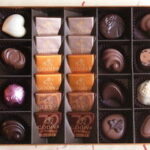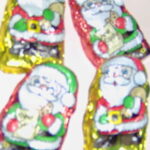It seems ironic that this particular chocolate company was named after a famous lady who rode naked through the streets of in order to force her husband to reduce taxes on his impoverished serfs. That would suggest that by choosing this legend, the company wanted their chocolates to be affordable to the “little people”. However, this is far from the case. Godiva chocolates have always been are some of the most expensive on the market today, and I’m afraid that the point of that famous naked ride has totally escaped the modern day descendants of their founder Joseph Draps, as I’m afraid no amount of reduction in taxes could make these chocolates affordable to serfs.
Of course, I could be missing the point here, and perhaps the idea of a beautiful woman, riding a lovely steed clad in only her tresses is supposed to symbolize elegance, class, sophistication and beauty. In which case, perhaps these chocolates are aptly named. Godiva’s tradition for gorgeous looking chocolates has never been compromised. Their attention to detail is beyond compare. Open any box of truffles or pralines and your eyes will be greeted to a lovely site indeed. To achieve this, Godiva uses two methods – enrobing and shell-molding. The former is a way of dipping a filling into chocolate to cover the filling completely. You’ll find that most rounded and smooth shaped chocolates are enrobed in this fashion. The shell-molding is where chocolate is poured into a mold, and then the mold is turned upside down so that only a coating of chocolate is left on the sides of the mold. When that’s cooled, the coating is taken out, filled and then closed up with a type of chocolate lid. You’ll find most decorative chocolates are made this way in order to achieve special and unusual shapes – like hearts and flowers and seashells, for instance.
Godiva is also well known for their beautiful packaging, using the most elegant of colours – gold – to highlight their products. In fact, their packaging is so opulent that it sometimes seems to outweigh the amount of product inside! It’s a type of mind-game, I suppose – covering a box of chocolates in gold to suggest that what’s inside is worth its weight in that substance. It is true that at one time cocoa beans were once considered worth more than their weight in gold (back when cocoa was first discovered), but today that just isn’t quite the case (though it’s still a good commodity to invest in, if you’re into investing in futures). That doesn’t justify the prices that Godiva charges for their chocolates.
Okay, so we’ve established that they’re beautifully designed, packaged and very expensive. The question is, does their texture and taste live up to both of these qualities?
In the world of chocolate (as in the world of beverages), the texture of the product is better known as ‘mouthfeel. You can probably imagine from the word itself what it’s describing – simply put, the way it feels in your mouth. A really fine chocolate will be so well made that it feels like its melting in your mouth before you even bite down, and when you swallow the last bit, you should feel as if your mouth has been cleansed, but leaving just a hint of the flavour at the back of your throat, with perhaps some traces of undertones at the back edges of your tongue. There should be a slight sweetness in your mouth this isn’t too heavy, but just pleasantly refreshing. With Godiva chocolates, it is in this area where their first downfall occurs. If I had to sum it up in one word, I’d say that Godiva chocolates have a distinctively waxy mouthfeel to them.
What do I mean by waxy? Well, if you’ve ever eaten the most vile chocolate on earth, Hershey’s original milk chocolates, you’ll know exactly what I mean by waxy. Its as if they’ve added candle wax to the mixture, giving it an extremely chewy quality, which almost seems to leave a residue on your teeth, not to mention leaving your tongue feeling thick, as if you’ve just woken up with a bad hangover. Okay, now you’ve got the idea of what I’m talking about. So how waxy are Godiva’s chocolates? Well, they aren’t as bad as Hershey’s, but you will certainly feel as if you’ll need to give your back molars a really good brushing to get rid of the bits that don’t seem to dissolve or get swallowed. Furthermore, if you’re trying their milk or white chocolates, you could get a feeling at the back of your throat which will be on the heavy side – as if you’ve just eaten a large gulp of honey. And if you try their white chocolate, you might even detect some sensation of something akin to fine sand at the back sides of your tongue. This last bit could be because of the milk powder has been improperly dissolved or blended. This is less detectable in the milk chocolates, but I have found it to also be true when eating the US versions of Godiva milk chocolates. But don’t fret – the European ones don’t seem to have encountered this difficulty in their milk chocolates, but unfortunately, there is a touch of grainy-ness in their white chocolates. Doesn’t sound too promising, does it?
Still, I will have you know that some chocolates have such an amazing flavour that they can overcome a touch of stodgy mouthfeel. The question is, can Godiva come through enough to overcome this mouthfeel? Well, let me take each of the three types of chocolate in turn in order to give you my opinion of this.
White “Chocolate” – yes, I put that in quotation marks because anything that doesn’t have cocoa solids isn’t really chocolate. In any case, white “chocolate” should have as much other parts of the cocoa bean as possible – meaning, cocoa butter. Now, if you know anything about fats, you’ll know that pure cocoa butter melts at quite low temperatures. Therefore, in order to help this from becoming a pile of sludge on the shop shelves from spring through autumn (not to mention on a production line, in a wrapper or just in your hand), certain things are required to be added to the fats to keep it from this disastrous end. Usually this is a certain amount of milk powder, some flavouring and some type of vegetable fat. The key to a good white “chocolate” is keeping the cocoa butter content as high as possible. While Godiva’s white “chocolate” does seem to succeed in this area, as I mentioned before, they also seem a touch heavy-handed on the milk powder, giving it that grainy mouthfeel I mentioned above. Fortunately, the milky taste in this instance is quiet pleasant, giving a slightly buttery undertone to this “chocolate”, which allows a delicate tone from the cocoa flavour to seep through, almost as an after-thought. Godiva has also been careful not to over sweeten their white “chocolate” so that you might actually find the buttery undertone to be slightly salty on your pallette after you swallow. This is only partially cut by the vanilla flavour which adds a hint of liqueur like alcohol bite, which you might find akin to the taste of a dry, white wine – which I find to be very nice. The waxy mouthfeel here, caused by the addition of a touch too much vegetable fats, is a touch less pronounced in these “chocolates”, making Godiva’s white “chocolates” probably the best of the bunch.
Milk Chocolate – as mentioned before, here again, we have the unhappy combination of the waxy and grainy mouthfeel. But what is the major problem here is the overzealous hand with the milk powder. To my mind, a good milk chocolate shouldn’t feel overly milky, and Godiva’s milk chocolates seem to try a bit too hard to achieve a creamy taste to them. Since milk chocolates have cocoa solids in addition to the cocoa butter (as opposed to the white stuff), the predominant flavour of a good milk chocolate should still be these two ingredients, and not the milk powder. Godiva’s milk chocolates go beyond the pleasant creamy, buttery and slip into the “kinder egg” overly milky area. The milk flavour here is fairly heavy, making the cocoa solids take a back seat, and not allowing the full flavour of the cocoa to come through properly. In fact, one can taste a subtle nutty undertone to the cocoa here which I find is akin to the taste of roasted almonds. This would be very pleasant, if the mixture didn’t have so much sugar and vanilla added to it. The sweetness combined with the milk powder gives these chocolates a very amateurish taste (for wont of a better description) – as if they were made for kids and not for the more discerning pallette of adults and gourmets. Moreover, the appealing liqueur kick of the vanilla we noticed in the white “chocolates” has been hidden here – again by the milk powder and sugar. Lastly, their milk chocolate has a slightly dusty aftertaste to it – as if you’ve just swallowed a piece of lint from your dryer. I found this to be very unpleasant and I had to have a drink of water to get rid of the taste in my mouth. Still, Godiva doesn’t make the worst milk chocolates I’ve ever tasted – at least they don’t taste as if the milk has gone sour, like Hershey’s does.
Dark Chocolate – to my mind, this is the ultimate test of any chocolate maker. It is with these, that have an absence of any milk powder, and a reduced amount of sugar, that one can really analyze the quality of the cocoa used in their products. Godiva seems to use a fairly woody flavoured bean, one that hasn’t been over-roasted, giving it a touch of a fresh, grassy tone to it rather than a burnt one. Again, there is a hint of nuts included, and in this case, more of a hazelnut than an almond flavour comes through. As the nutty flavour calms, you might actually detect a touch of citrus – which would be very welcoming indeed if it was a clean orange or even lemon type of citrus. Unfortunately, the type of citrus you’ll taste is one akin to the scent of rotting peelings – to me it tastes like a moldy grapefruit. In addition, Godiva cannot seem to help but use something in an overhanded manner, and with their dark chocolates I feel it’s the vanilla (or more correctly, the artificial version of vanilla – vanillin) that has been abused. This gives a definitely astringent overtone to their dark chocolates, which isn’t in the least appealing and actually tastes on the medicinal side. This combined with the moldy grapefruit aftertaste made me want to spit out the last piece of their 70% dark chocolate I had. I must admit, however, that their 56% dark was less disgusting, probably because the higher sugar content partially disguised the moldy grapefruit and astringent flavours – thank heavens for small favours!
One cannot talk about Godiva chocolates and not mention the fillings they use in their truffles. I must admit that Godiva was an innovator in the realm of fillings, and uses the best methods available. They have been known to try some unusual combinations which quickly became public favourites. However that was in the beginning and today, more creative chocolatieres have discovered that there are even more unusual taste combinations that the public is willing to try – including some historically traditional ones that Godiva has shied away from, like cayenne pepper, ginger, green tea and cardamon, for instance. Of course, if you aren’t looking for excitingly new taste sensations, then you can count on Godiva to provide you with the basic standard truffle fillings that you’ve had all your life. By the way, I recently had a dark chocolate of theirs which was filled with raspberry, which was totally vile – the raspberry didn’t taste at all like any type of berry I’d ever tried, it had a sharp overtone akin to the taste of rusty nails – if you can imagine that. It was not a nice experience at all, and I had to spit it out!
Godiva has two factories – one in Belgium and the other in the USA, in New Jersey, to be specific. Chocolate experts believe that the quality of chocolates from the USA factory is inferior to those from the factory in Belgium. Since I’ve had very little experience of the chocolates from the USA, and considering all I’ve said above, I think you all should be thankful that you’re in Europe and aren’t being subjected to even further inferior chocolates than those the Americans are being accosted with. I should also mention that be this as it may, I’m under the impression that price-wise, the chocolates being produced in the USA are actually more reasonable. Of course, if they don’t taste even as “good” as those in Europe… I think you get the picture.
Bottom line – it is possible that Godiva were the benchmark for quality chocolates back when they were a small concern. However, it is my belief that since they’ve spread their wings and become popular – or should I say ‘internationally famous’ – the quality of their products have deteriorated exponentially. They are certainly not worth the prices you’ll be asked pay for them. They are no longer trying anything new with their flavour combinations and if you ask me, their selection now looks a bit stodgy. I’ll give them three stars, only because they have come as close as anyone to making a white “chocolate” that’s almost pallatable. Sorry, my dear Lady, if this review has toppled you off your high horse, but to be totally honest, you’re looking more like something out of the Emperor’s New Clothes these days!





